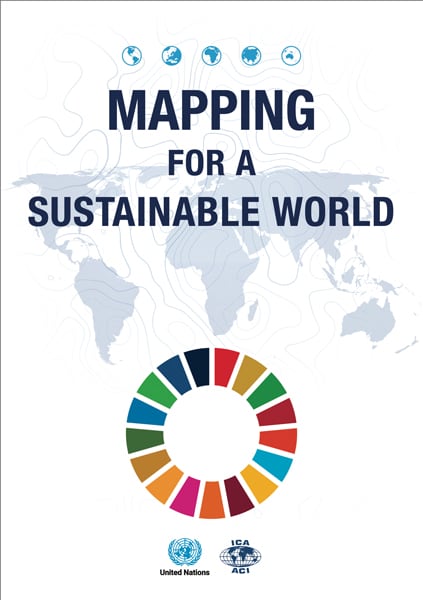Cartography is a highly effective tool for engaging with the Sustainable Development Goals (SDGs), the objectives set forth by the United Nations (UN) to ensure a more sustainable, equitable future. That’s why the International Cartographic Association (ICA) partnered with the UN to produce a valuable book—Mapping for a Sustainable World—for anyone interested in how mapping can contribute to understanding the SDGs.
Recently released as an e-book, Mapping for a Sustainable World is a must read for those who are contributing to or acting on the SDGs. At one level, it is a basic cartography textbook centered on the singular theme of the SDGs. But on another level, it shows how the processes involved in making maps, including managing data, can pinpoint areas that need more attention and, ultimately, help achieve the SDGs.
A Big Topic Revolving Around One Theme
Mapping for a Sustainable World has myriad uses, from educating those who seek knowledge about the world to supporting experts in one of the many disciplines—cartography—that can be wielded to attain these goals.
As Kyoung-Soo Eom, chief of the UN’s Geospatial Information Section, notes in the foreword to the book, “The United Nations Secretary-General called for making better use of data so that everyone, everywhere uses data for insight, impact, and integrity.” Cartography does this, he continues, by enabling people to analyze large amounts of data and visualize the results.

According to the editors of Mapping for a Sustainable World, the book offers “guidelines for mapping geographic datasets related to the SDGs by introducing basic principles of map design and use, discussing established best practices and conventions, and explaining how different mapping techniques support understanding of the SDGs.”
In a sense, then, this is a book about cartography, the various types of data used for mapping, and how one can create different maps—all using the SDGs as a common theme. This single-purpose approach to teaching the fundamentals of cartography enriches the value of the practice by also fostering increased knowledge about the SDGs.
An Extensive Survey of Cartography
Mapping for a Sustainable World is divided into four sections: SDGs & Geospatial Data, Map Design Considerations, Maps & Diagrams, and Map Use Environments.
The first section describes the SDGs and goes over the characteristics of many SDG indicators, introducing readers to some of the types of data required for each indicator. This section also examines the geospatial information that’s needed to address the indicators’ intrinsic complexities. General information, definitions, and numerous examples give readers context about different kinds of data—such as geospatial, attribute, and statistical data—in an easy-to-understand style. Descriptions of how data is organized and made available for the SDGs is beneficial for helping readers develop a fuller understanding about the nature of the data and how to apply it to cartographic applications. The value of cartography is made evident in a segment on visual style, which states that the “treatment of map design as an artistic process enables new ways to humanize the otherwise abstract statistical SDG indicator data.” Helpful links to resources and current efforts coordinated by various UN expert and working groups provide up-to-date information for anyone interested in more detail.
The second section, on map design, introduces novice mapmakers to the assorted components, options, and decisions involved in creating an effective cartographic portrayal. As the first line of this section affirms, “Designing a map is not a trivial task”—a point that is evident throughout the book as the authors demonstrate all the decisions cartographers must make, many of which are not perfect or preferred because of the nature of the data being mapped or other limitations. For example, how do cartographers proceed when data is either deficient or missing? Identifying when data elements need attention is just one of the many ways that cartographic processes can inform SDG-related data management efforts.
Different types of maps and diagrams are described in the third section, which emphasizes how choosing the best depiction depends on the final product’s purpose and intended use. For instance, the authors point out that making thematic maps of indicator data is a requirement for meeting the SDGs. They then use sample datasets to put together thematic map designs—from choropleth maps to dot density maps—to show the visual variations of particular map displays.
The last section of the book focuses on map use environments, which involves looking at the characteristics of different audiences. Because the SDGs are critical to tackling the biggest challenges facing our world today, map content and design often need to speak to decision-makers, political leaders, and other influencers and champions of the varied topics within the 17 SDGs. A key focus of this section describes diverse user environments, which, due to technology, have opened up many new ways for users to make maps and for audiences to experience them. Anyone interested in learning more and seeing examples of mapping data associated with each SDG will find the various visualizations presented in this section useful.
The afterword closes the book with important summaries, observations, and lessons learned. As the authors explain, the data needed to achieve the SDGs is voluminous, complex, and disparate, yet the visualizations made possible through mapping offer compelling options for seeing, informing, and ultimately understanding it all in a variety of ways, depending on one’s needs, interests, and intended use. Put simply, maps aid in making complicated numbers and messages easier to understand.
An Unfinished, Ongoing Process
Mapping for a Sustainable World reveals, yet again, how maps and mapping are critical for solving real-world challenges. The strength of this single-themed cartography book, with its focus on the SDGs, is in its examples. They show readers how to use several techniques to map a variety of data and encourage practitioners to apply similar approaches to data at the subnational level. This, however, often presents challenges—albeit also unique solutions.
Cartographers are still limited by a lack of small-area statistics for many communities. Currently, most SDG mapping reflects national-level datasets. To facilitate real change, there needs to be an increased focus on collecting data at ever more local levels to facilitate small-area mapping. Imagine the value of being able to visualize community-level data as it relates to national- and global-scale SDG indicators—and then making relevant decisions based on that.
According to observations made by the book’s contributors, it is clear that even though there is a plethora of data that supports the SDGs, this data is incomplete and/or inconsistent. Additionally, the availability of SDG data and associated mapping is not the end of the story, nor will that meet all the challenges presented by the SDGs. As the authors state, “mapping the SDGs is much more of an ongoing process than a final product.”
Efforts in working to achieve the SDGs have begun to expose topics that need to be explored at the global, national, and local levels to improve the world in which we live. In 2015, the 17 goals, targets, and indicators that were identified as the SDGs were classified as some of the most important global issues that need to be addressed. While their relevance has not lessened, other issues have come to the forefront—including racial disparity, social injustice, and climate change’s even wider-reaching effects—that can benefit from similar attention.
So please, seek out, explore, and use Mapping for a Sustainable World. As mentioned in a section on open access, the SDG datasets and cartographic guidance in this book are openly available. That means that more people than ever before can make maps in support of an economically, environmentally, and socially sustainable future.


